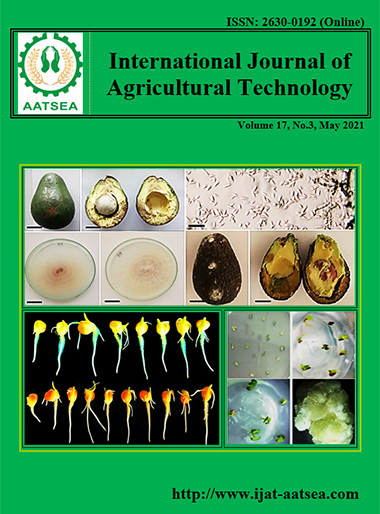Impact of water-saving method on grain yield of rice var. Khao Hawm Mae Paya Tong Dam in irrigated fields
Main Article Content
Abstract
This study focused on the grain yield of rice var. Khao Hawm Mae Paya Tong Dam (KHMPTD) in alternate wetting and drying when the perched water is at 20 cm below soil surface (AWD20), and at 10 cm below soil surface (AWD10), and continuous flooding (CF) irrigation methods after transplanted with 12-day old (S12) and 25-day old (S25) seedlings. There was an increase in grain yield and reduction in plant height at vegetative growth in AWD10 compared with AWD20 and CF. Grain yields in AWD20 and AWD10 were higher by 2% and 13%, respectively, than in CF. AWD20 and AWD10 can reduce irrigation water application by 74% and 47%, respectively. Less irrigation water application to produce 1 kg of unmilled rice grain in AWD20 and AWD10 contributed to having significantly higher values of water productivities with no penalty on grain yields as compared with that in CF. Through stepwise multiple regression analysis, grain yields in AWD20, AWD10, and CF can be explained by water productivities with 100% accuracy as grain yields had the positive coefficient values with water productivities. Grain yield from transplanted S12 was significantly higher by 47% than transplanted S25 due to significantly higher productive tillers per plant. Grain yields were significantly affected by irrigation method and seedling age management. Only grain yield in AWD10xS12 (8.43 t/ha) was significantly higher than in CFxS12 (a controlled treatment; 7.83 t/ha). Consequently, its shorter plants required less irrigation water application (7,623 m3 water/ha) and less amount of irrigation water application to produce 1 kg unmilled rice grain (905 L water/kg grain), 43% water saving, and without the reduction of grain yield. This raised the water productivity up to 1.11 kg grain/m3 water. Therefore, AWD10xS12 served as the best water-saving method to produce more rice var. KHMPTD in irrigated rice fields
Article Details

This work is licensed under a Creative Commons Attribution-NonCommercial-NoDerivatives 4.0 International License.
References
Borell, A., Garside, A. and Fukai, S. (1997). Improving efficiency of water use for irrigated rice in a semi-arid tropical environment. Field Crops Research, 52:231-248.
Bouman, B. A. M., Feng, L, Tuong, T. P., Lu, G., Wang, H. and Feng, Y. (2007). Exploring options to grow rice under water-short conditions in northern China using a modelling approach. II: Quantifying yield, water balance components, and water productivity. Agriculteral Water Management, 88:23-33.
Cantrell, R. P. and Hettel, G. P. (2004). New challenges and technological opportunities for rice-based production methods for food security and poverty alleviation in Asia and the Pacific. Presented at the FAO Rice Conference, FAO, Rome, Italy, pp.12-13.
Food and Agriculture Organization (FAO) (2001). World agriculture: towards 2015/2030. Earthscan Publications Ltd London. pp.444.
Gomez, K. A. and Gomez, A. A. (1984). Statistical Procedures for agricultural research. John Wiley and Sons, New York.
Guerra, L. C., Bhuiyan, S. I., Tuong, T. P. and Barker, R. (1998). Producing more rice with less water from irrigated methods. SWIM Paper 5. IWMI/IRRI, Colombo, Sri Lanka, pp.24.
Khairi, M., Nozulaidi, M., Afifah, A. and Jahan, M. S. (2015). Effect of various water regimes on rice production in lowland irrigation. Australian Journal of Crop Science, 9:153-159.
Lertnimitmongkol, W. and Mongkontanawat, N. (2020). The Development of “Khao Hawm Mae Paya Tong Dam Black Rice” (Oryza sativa L.) Bar mixed with Fried Pisang Mas (Musa Sapientum). Rajamangala University of Technology Srivijaya Research Journal, 12:362-373.
Lu, J., Ookawa, T. and Hirasawa, T. (2000). The effects of irrigation regimes on the water use, dry matter production and physiological responses of paddy rice. Plant and Soil, 223:207-216.
O’Toole, J. C. (2004). Rice and water: The final frontier. Paper presented at the First International Conference on Rice for the Future, Bangkok, Thailand.
Pasuquin, E. M., Lafarge, T. and Tubana, B. (2008). Transplanting young seedlings in irrigated rice fields: Early and high tiller production enhanced grain yield. Field Crops Research, 105:141-155.
Pasuquin, E. M., Tubana, B., Bertheloot, J. and Lafarge, T. A. (2004). Impact of early transplanting on tillering and grain yield in irrigated rice. New directions for a diverse planet: Proceedings of the 4th International Crop Science Congress Brisbane, Australia, 26 Sep-1 Oct 2004.
Song, T., Xu, F., Yuan, W., Zang, Y., Lui, T., Chen, M. and Zhang, J. (2018). Comparison on physiological adaptation and phosphorus use efficiency of upland rice and lowland rice under alternate wetting and drying irrigation. Plant Growth Regulation, 86:195-210.
Tabbal, D. F., Bouman, B. A. M., Bhuiyan, S. I., Sibayan, E. B. and Sattar, M. A. (2002). On-farm strategies for reducing water input in irrigated rice: case studies in the Philippines. Agricultural Water Management, 56:93-112.
Thakur, A. K., Mohanty, R. K., Patil, D. U. and Kumar, A. (2014). Impact of water management on yield and water productivity with system of rice intensification (SRI) and conventional transplanting system in rice. Paddy Water Environment, 12:413-424.
Thai Rice Exporters Association (TREA) (2019). Rice Yield. (Online). Retrieved from http://www.thairiceexporters.or.th/production.htm, July 29, 2020.
Wiangsamut, B., Lafarge, T. and Mendoza, T. C. (2013). Water productivity of 2 rice genotypes grown in different soil textures and irrigated through continuous flooding and alternate wetting and drying irrigation methods. Journal of Agricultural Technology, 9:1545-1560.
Yamazki, K. and Harada, J. (1982). The root system formation and its possible bearings on grain yield in rice plants. Japan Agricultural Research Quarterly, 15:153-160.
Yang, J., Zhou, Q. and Zhang, J. (2017). Moderate wetting and drying increases rice yield and reduces water use, grain arsenic level, and methane emission. The Crop Journal, 5:151-158.
Zhang, H., Xue, Y., Wang, Z., Yang, J. and Zhang, J. (2009). An alternate wetting and moderate soil drying regime improves root and shoot growth in rice. Crop Science, 49:2246-2260.


